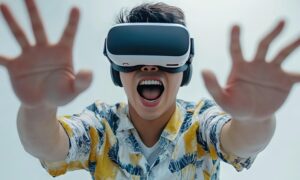NDIS-Assistive Technology is an essential part of the Australian national disability framework, helping Australians who are either permanently or temporarily disabled to live full, happy, and healthy lives with the aid of assistive technology.
As Australia’s relationship with technology evolves, so must its governmental agencies. The NDIS scheme is the latest in the government’s attempts to utilize artificial intelligence to better the lives of the Australian people.
Recent years have seen NDIS-assistive technology strengthen, benefiting workers and clients across Disability Care, both in-office and on the go, by improving access to the National Disability Insurance Scheme.
What emergent technologies are assisting NDIS workers?
There are a few ways in which NDIS workers utilize emergent technologies such as artificial intelligence, cloud-based client software, video chat, voice-control technology, and more. Here are a few emerging technologies that NDIS uses to assist Australians daily.
1. Client management software
The computer has forever changed how the NDIS operates, and the most recent software to help workers manage their client caseload has been a quintessential part of that evolution. NDIS client management software allows aged-care workers to input identification information, make notes, and access all client information in a mobile-compatible, cloud-based service.
2. Automatic start and automatic door opening
Controlled using a mobile or key-fob device, you can automatically start or open your car doors. This is an excellent option for those with upper-body paralysis or partial or complete limb loss of hands or arms.
3. Text-to-speech assistive technology
Otherwise known as dictation technology, text-to-speech capabilities vastly improve people’s lives with learning disabilities or sensory impairments. Text-to-speech technology opens doors for more precise communication and is a lifeline for those who rely on their voices as their primary communication method.
3. Voice control and command technology
While we may see Amazon’s Alexa or Google Home as something of a commodity, for those without arms or legs, turning the light on and off can be a frustrating and challenging task, even with prosthetic limbs. Voice control and command technology such as Google Home significantly improves the at-home life of people who struggle with limb loss.
5. Virtual reality
The use of virtual reality for persons with disabilities has many applications across many sectors and for many people with disabilities. Particularly when it comes to sight loss or memory function loss, such as in patients with dementia and Alzheimer’s, using VR for those with vision loss enables them to see a world they would otherwise not be able to.
For those with total blindness, audio and haptic feedback assist them while using VR platforms. Virtual reality can also be of assistance to those with memory problems. and several studies show that it even improved memory function in certain patients.
6. Companion robots
Healthcare professionals try their level best to take the strain off loved ones for elderly patients who may be living alone or dealing with debilitating health problems that prevent them from performing basic daily tasks.
However, it’s no secret that the healthcare system is overloaded and understaffed. Thus, technology has allowed the creation of and targeted deployment of companion robots within medical trials to help patients perform self-care and basic household tasks. This research is still in the very early stages of development. However, it offers a promising glimpse into the future.
7. Wearable medical devices
Wearable medical devices that can monitor patients when help can’t be there are critical parts of the healthcare infrastructure of at-home care. Today, wearable medical devices like the Apple Watch track more than movement and offer fall detection.
Wearable blood glucose monitors can alert a healthcare professional if your blood sugar is falling too low, or a wearable ECG monitor tracks your heart rate. Wearable blood pressure monitors can monitor patients suffering from hypertension or other medical conditions.
Many wearable devices can be monitored remotely, like at a hospital or primary care center. Even modern pacemakers have the potential to be monitored off-site and can provide a life-saving jolt to restart the heart in patients with heart problems.
Emergent technology offers NDIS a new field of opportunity to assist those needing our help while embracing change and improving our patients’ daily lives.



































